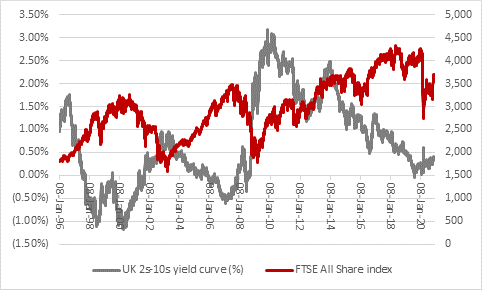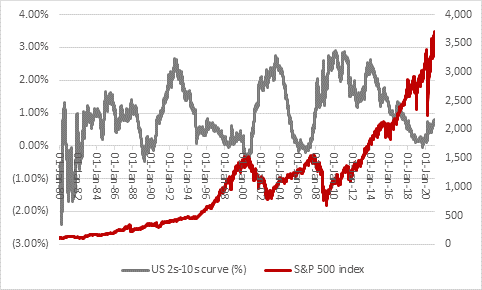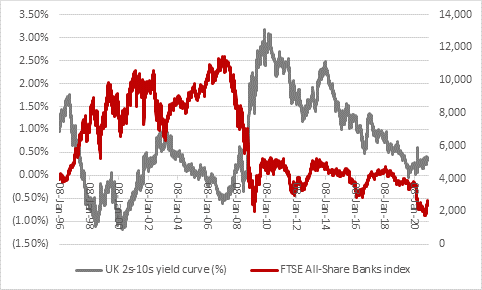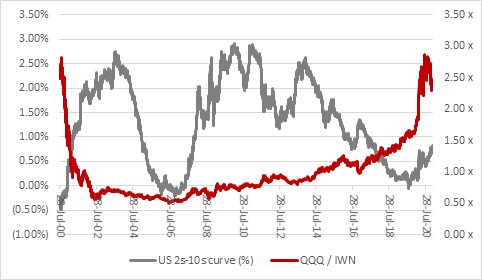“No investment indicator is infallible – if it were, none of us would be working - but one which is generally held to stand the test of time is the yield curve,” says Russ Mould, AJ Bell Investment Director. “The bond-market metric is suggesting that an economic upturn (and possibly inflation) is on its way and, if it is right, then this has huge implications for financial markets and asset allocation strategies overall, as well as fund and specific stock selection strategies.
“As defined by the premium yield offered by ten-year Government bonds relative to two-year paper (the 2s10s, to use market jargon) the yield curve in the UK stands at its steepest since August 2019, while in the USA the yield premium offered by ten-year US Treasuries relative to two-year paper is at its highest since October 2017.
“However, one which is generally held to stand the test of time is the yield curve so investors may be intrigued to learn that the curve in the UK stands at its steepest since August 2019 (barring a blip in March of this year), while in the USA the yield premium offered by ten-year US Treasuries relative to two-year paper is trading near to its highest since October 2017.
“There remains the possibility that central bank interference in the bond market via Quantitative Easing means that the yield curve may be less useful now and could even be giving false signals – after all, QE is designed to suppress bond yields and help Governments fund their rapidly-building debts. The indicator has been of little use in Japan since 1990, presumably thanks to the Bank of Japan’s interest rate and QE policies, although it has had its moments in the UK.
“Inverted yield curves in 2000 and 2007 helped to call the top for the FTSE All-Share index but a marked steepening marked the beginning of bull runs in 1998, 2003 and in the early stages of the last decade.

Source: Refinitiv data
“Equity market bulls may also be pleased to see a steeper curve in the USA, as markets take their lead from hopes for further momentum the race for a COVID-19 vaccine and further fiscal stimulus from Congress, as well as the prospect of ongoing monetary largesse from the US Federal Reserve.
“A steeper curve characterised the early stages of the US equity bull markets that began in 1982, 1990, 2002 and 2009.

Source: Refinitiv data
“If history does repeat itself – and there is admittedly no guarantee on that front – then there may be further implications below the level of headline indices as well.
“Banking stocks, for example, have been crushed by central banks’ efforts to keep yields low (and by implication yield curves flat) as they try to help Governments fund their burgeoning debts. A steeper curve could boost banks’ net interest margins, earnings power, share prices and ability to pay dividends. This could be influential in the UK market, for example, where the FTSE 100’s Big Five banks are so integral to earnings and dividend growth forecasts.

Source: Refinitiv data
Even more intriguingly, a steeper yield curve, hinting as it does of a stronger economy and inflation, seems to favour cyclical earnings growth over secular earnings growth – or, to put it more crudely, ‘value’ as a style over ‘growth’ – at least if history is any guide.
‘Value’ has tried to forge a recovery relative to ‘growth’ since the summer and the trend has become more pronounced since the Pfizer-BioNTech vaccine announcement in early November. This can be gauged by using the ratio of the price of the Invesco QQQ Trust, an US-quoted exchange-traded fund (ETF) designed to track and deliver the performance of the heavyweight NASDAQ 100 index (minus its running costs), relative to the iShares Russell 2000 Value ETF, as a benchmark.

Source: Refinitiv data
“Some are wondering if this growth-to-value trade is already exhausted.
“Looking back at 2000, you could argue that it has hardly begun, such was the violence of the switch from growth to value as the former began to falter under the twin weights of lofty valuations and earnings disappointment and this is something that holders of momentum favourites such as Apple, Facebook, Netflix, Microsoft, Alphabet, Tesla and others need to keep an eye on, just in case.”
